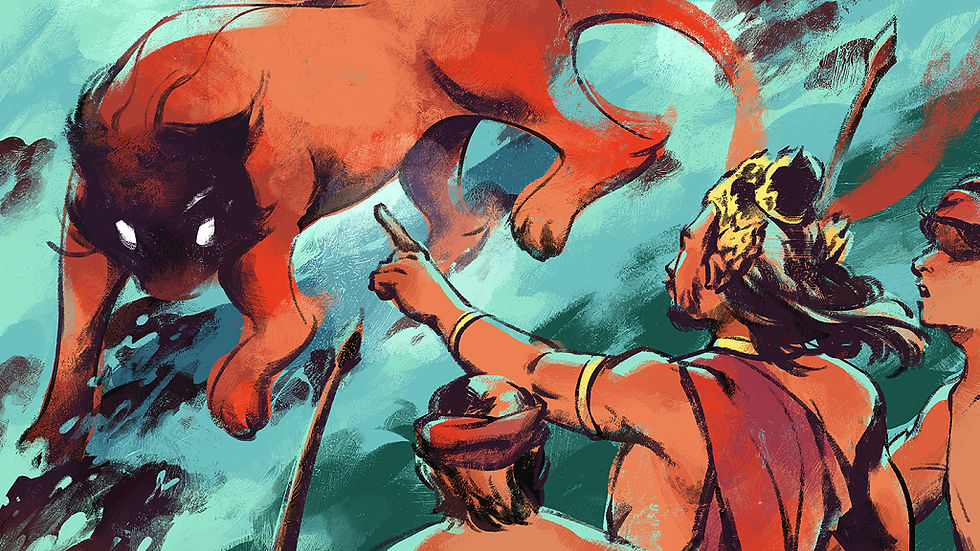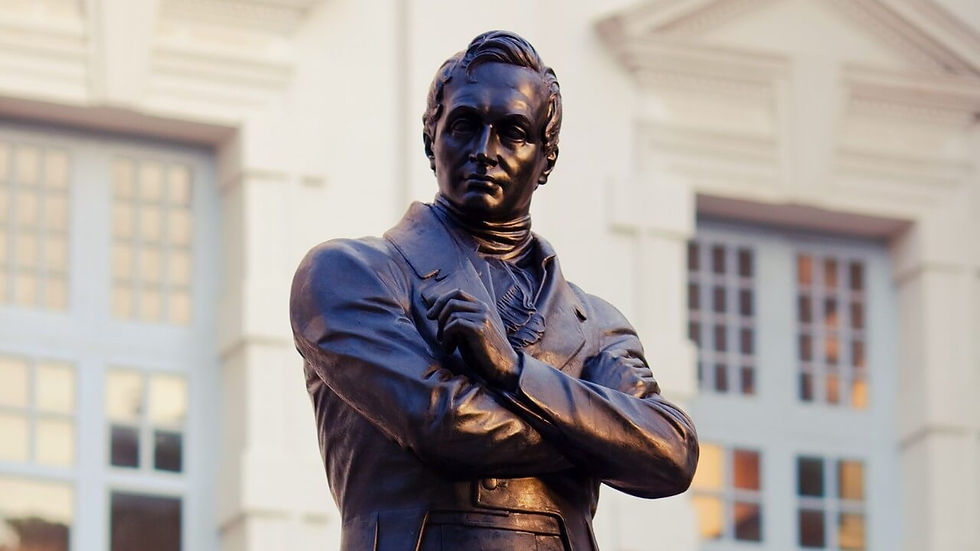The Story Behind the Singapore Name
- lionheartlanders

- Aug 5
- 7 min read
Have you ever wondered how Singapore got its distinctive name? The story behind the Singapore name is a fascinating blend of historical fact and captivating legend that takes us back centuries. While we now know this vibrant city-state as a global hub, its journey from the ancient settlement of Temasek to the "Lion City" we know today is filled with royal encounters, mystical creatures, and colonial decisions that shaped the region's destiny.
Singapore's naming story isn't just about geography, it's about Lion City Stories that reveal the deeper cultural heritage and the remarkable transformation of this strategic island. Let's embark on this journey through time to uncover the legendary tale and historical facts that gave Singapore its enduring identity.
The Earliest Name: Temasek

Before Singapore became the Lion City, it was known by a much different name: Temasek. This ancient moniker, derived from the Malay word "tasik" meaning "lake" or "sea," essentially translates to "Sea Town". The name perfectly captured the island's maritime character as a strategic trading post surrounded by water.
Temasek appears in several important historical documents, proving its significance in the region's early history. The most notable reference comes from the Nagarakretagama, an Old Javanese eulogy written in 1365, where the settlement is mentioned as "Tumasik". This document, along with other historical records, shows that Temasek was recognized as an important location in the trading networks of Southeast Asia during the 13th and 14th centuries.
Chinese records also provide valuable evidence of the settlement's existence. The Yuan dynasty traveler Wang Dayuan, who visited the island around 1330, described a place called "Danmaxi" (單馬錫), which historians believe is a transcription of the name Temasek. Vietnamese records from the same period refer to it as "Sach Ma Tich," further confirming the settlement's regional importance.
During this period, Temasek was strategically positioned within the sphere of influence of the powerful Srivijaya Empire, centered in Palembang. The settlement served as a crucial stopover point for merchants traveling between China and India, making it a valuable prize for regional powers. Later, it would come under the control of the Majapahit Empire, as evidenced by its inclusion in the famous Sumpah Palapa (Palapa Oath) pronounced by Mahapatih Gajah Mada.
The Arrival of Sang Nila Utama

The transformation from Temasek to Singapore begins with one of Southeast Asia's most enduring legends: the arrival of Sang Nila Utama. According to the Malay Annals (Sejarah Melayu), this Srivijayan prince from Palembang would forever change the island's destiny.
The legend tells us that Sang Nila Utama was born into the royal family of the Srivijaya Empire, with his official title being Sri Tri Buana, meaning "Lord of Three Worlds". Around 1299, during a time of political upheaval when the Majapahit Empire was expanding its influence, the prince found himself seeking new territories beyond the reach of these emerging powers.
The story begins on Bintan Island, where Sang Nila Utama was hunting. While pursuing a swift deer up a hill, the animal mysteriously vanished when he reached the summit. From this vantage point, the prince spotted an island in the distance with pristine white sandy beaches that caught his imagination. When he asked his chief minister about this mysterious island, he was told it was Temasek.
Determined to explore this new land, Sang Nila Utama set sail with his entourage. However, their journey was fraught with danger. A violent storm erupted while they were at sea, threatening to sink their vessel. As waves crashed over the ship and it began taking on water, the crew threw everything heavy overboard to lighten the load. When this proved insufficient, the ship's captain advised the prince to throw his crown into the sea as an offering to calm the waters. This royal sacrifice worked—the storm immediately subsided, allowing them to reach Temasek safely.
The Lion Legend

Upon landing on the shores of Temasek, Sang Nila Utama embarked on a hunting expedition near what is now known as the Padang. It was during this hunt that the most pivotal moment in Singapore's naming history occurred—the legendary sighting that would give the island its enduring identity.
According to the Malay Annals, while hunting near the river mouth, the prince suddenly encountered a magnificent creature unlike any he had seen before. The beast was described as having a red body, black head, and white breast. Its appearance was both majestic and fierce, capturing the prince's immediate attention before it swiftly disappeared into the jungle.
Intrigued by this mysterious animal, Sang Nila Utama turned to his chief minister, Demang Lebar Daun, and asked what creature they had witnessed. The minister, drawing upon his knowledge of Sanskrit texts and Hindu-Buddhist mythology, declared that it was a "singa" (lion). In the cultural context of the Srivijayan court, where Sanskrit was the language of prestige and lions held deep symbolic significance as royal creatures associated with power and good fortune, this identification carried immense meaning.
The prince interpreted this sighting as an extraordinarily auspicious omen. In Hindu and Buddhist traditions, which were central to Srivijayan culture, lions symbolized strength, courage, and divine protection—qualities essential for establishing a new kingdom. The creature's majestic appearance convinced Sang Nila Utama that this was the perfect location to found his new city.
Modern scholars have noted an interesting historical reality: lions have never been native to Southeast Asia. The closest wild lion populations to Singapore were found in India, thousands of kilometers away. What Sang Nila Utama and his entourage most likely encountered was a Malayan tiger, which was abundant in Singapore's dense forests during the 13th and 14th centuries. However, this biological fact doesn't diminish the cultural and symbolic power of the legend—it simply adds another layer to the story's complexity.
The Birth of Singapura

Inspired by the mystical encounter and convinced of its positive significance, Sang Nila Utama made a momentous decision that would echo through centuries. He chose to establish his new kingdom on Temasek and rename the island to reflect this divine encounter. Thus was born "Singapura"—a name that combines two Sanskrit words with profound meaning.
"Singapura" derives from "simha" (सिंह), meaning "lion," and "pura" (पुर), meaning "city" or "fortress". This linguistic combination literally translates to "Lion City", creating a name that was both descriptive and aspirational. The choice of Sanskrit was particularly significant, as it was considered the prestigious international language of the region during that era. Sanskrit names conveyed cultural sophistication and divine authority, lending legitimacy to the new settlement.
The name Singapura wasn't unique to this island settlement. Historical records show that several other places in Southeast Asia bore similar lion-inspired names, including Simhapura in what is now Vietnam, which served as the capital of the Champa kingdom from the 4th to 8th centuries. This pattern suggests that "lion cities" represented an important cultural concept throughout the region, symbolizing strength, prosperity, and divine favor.
Under Sang Nila Utama's rule, which lasted 48 years until his death in 1347, Singapura flourished as a prosperous trading center. The kingdom attracted merchants from across Asia, establishing itself as a crucial link in the maritime trade networks connecting China, India, and the Malay archipelago. The strategic location that had made Temasek valuable continued to serve Singapura well, transforming it into one of the region's most important commercial hubs.
The success of early Singapura validated the prince's decision to name it after the lion. The city became known throughout the region for its prosperity and strategic importance, with the name Singapura appearing in various forms in historical documents and maps from different cultures and time periods. This widespread recognition helped establish the Lion City's reputation far beyond its geographical boundaries.
The British Arrival and Name Retention

The legend of Singapura and its lion-inspired name survived centuries of changing rulers and political upheavals. When Sir Stamford Raffles landed on the island on January 28, 1819, he encountered not just a strategic location, but also a place with a rich cultural heritage and an established identity.
Raffles, representing the British East India Company, was seeking a strategic base to counter Dutch influence in the region and secure British access to the vital trade routes between China and India. The island he found was sparsely populated, home to only about 150 inhabitants—120 Malays and 30 Chinese—living under the authority of a Temenggong from Johor.
Despite the island's relatively modest population, Raffles recognized both its strategic potential and its historical significance. Rather than imposing an entirely new British name, he made the pragmatic decision to retain the existing name "Singapura". This choice demonstrated both respect for local tradition and an understanding that the established name already had regional recognition and commercial value.
On February 6, 1819, Raffles signed the historic Treaty of Singapore with Sultan Hussein and Temenggong Abdul Rahman, officially establishing British control over the island. From this moment, the Union Jack flew over Singapore, but the ancient name persisted, bridging the gap between the legendary kingdom of Sang Nila Utama and the modern British colonial settlement.
The British simply anglicized the pronunciation from "Singapura" to "Singapore," making it easier for English speakers while preserving the essential meaning and cultural significance. This linguistic adaptation ensured that the Lion City's identity remained intact even as it embarked on a new chapter as a British trading post and eventual global hub.
Raffles' decision to maintain the Singapore name proved prescient. The name provided continuity with the past while the British administration built the foundation for the modern city-state. Under British rule, Singapore grew from a small trading post into one of the world's most important ports, with the Lion City moniker becoming internationally recognized and respected.
Final Singapore Name
The story behind the Singapore name represents a remarkable fusion of legend and history, myth and reality. From its origins as the humble "Sea Town" of Temasek to its transformation into the legendary Lion City through Sang Nila Utama's mystical encounter, and finally to its retention by practical British colonizers, the name Singapore embodies centuries of cultural evolution and adaptation.
Today, as you walk through the bustling streets of modern Singapore, you're experiencing the legacy of that legendary moment when a Srivijayan prince decided to name his new kingdom after a magnificent creature that symbolized power, courage, and good fortune. Whether that creature was truly a lion or more likely a Malayan tiger matters less than the enduring power of the story itself.
The Singapore name continues to resonate because it captures something essential about this remarkable place—a city that has always been a meeting point of cultures, a hub of commerce, and a symbol of transformation and possibility. The Lion City's story reminds us that names carry power, and the stories behind them help shape the identity of the places we call home.
For those who want to explore more fascinating stories about Singapore's rich heritage and discover the hidden layers of this incredible city-state, Lion City Stories offers deeper insights into the tales that shaped our nation. After all, understanding our past helps us appreciate the remarkable journey that transformed a small island settlement into the global metropolis we know and love today.




Comments